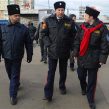
Cossack Separatism Again on the Rise
Publication: Eurasia Daily Monitor Volume: 10 Issue: 105
By:

Sixty-eight years ago this week, the Western allies forcibly returned to the Soviet Union more than 2,000 Cossacks who fought on the German side against Stalin during World War II. Some were executed and even more died in Soviet uranium mines. But Cossacks continue to remember what they call thiss the Lienz tragedy because it highlights the fact that while most Cossacks at present see themselves as defenders of the Russian state, an increasing number believe they are a nation oppressed by Moscow and deserve self-determination in some territorial form.
Paradoxically, the Kremlin stands behind this new upsurge in Cossack separatism because of its use of Cossack units not only in central Russian cities but in the North Caucasus. Three of the most important of the 13 Cossack “voiskas” or hosts—the Don, the Kuban and the Terek forces—have their roots in the North Caucasus and had set up Cossack states there during the Russian Civil War (themoscownews.com/local/20121126/190912705.html). So strong were those efforts that the Soviet state became deeply suspicious of any Cossack activity and took steps to ensure that the Cossacks could never become a challenge to the Soviet state and its territorial organization.
Since the collapse of the Soviet Union, however, Moscow has been more deferential to the Cossacks in the hopes that they could help control the Caucasus and Caucasians, but it has not been willing to allow them to restore any territorial units despite the Russian state’s continuing support for non-Russian autonomous units. One pro-Cossack writer, Andrei Kovalenko, notes that Moscow’s failure to support the Cossacks even as it asks them to help defend the Russian state was driving ever more of the members of that community to think of themselves as a nation with the territorial rights that status entails (evrazia.org/article/1397).
Some of them, Kovalenko points out, are now talking about the restoration of a Don Cossack Republic. “In Novocherkassk,” he continues, “in semi-underground conditions, a constitution of the newly minted republic is being drafted, and corresponding documents are being prepared for dispatch to the United Nations.” And according to another Cossack ideologist, Alexander Yudin, “there exists a definite order of actions which must be taken in order to form everything by law. In the near term,” he continues, “we will define the borders of the state, prepare a legal basis, and seek [diplomatic] recognition at the United Nations” (evrazia.org/article/1397).
As Moscow knows well from bitter experience, changing borders in the North Caucasus is a risky proposition. A Cossack republic, even if limited in space, would have to be hacked out of several non-Russian areas, including Chechnya and the Circassian republics of the western Caucasus, as well as predominantly Russian areas like Stavropol Krai. Consequently, most Cossack activists are now focusing on restoring their traditional “stanitsas”—villages within the Cossack hosts and, historically, units of economic and political organization of the Cossack peoples. At the present time, several dozen have been re-formed without much official acknowledgement. But even doing that informally is creating problems, not only because they too require a shift of territorial control from one ethnic group to another, but because they appear to presage something far larger (https://avrom-caucasus.livejournal.com/258900.html and avrom-caucasus.livejournal.com/257828.html).
Three aspects of this Cossack revival are worth noting. First, Cossack activism is not simply a revenant from the past but a symbol of the growing importance of sub-ethnic communities within what Moscow calls the Russian nation. Those subdivisions, based on regionalism as in Siberia or the northwest, or historical experiences as in Novgorod or the Cossack areas, highlight the weakness of Russian ethno-national identity and the very real possibility that the Russian state will not be able to rely on one part of that community without alienating another. Indeed, as Yudin pointed out in the article cited above, the Cossacks may ultimately become a model for the various groups now lumped together as Russians (evrazia.org/article/1397).
Second, Moscow’s experience with the Cossacks over the last ten years and the way that the Cossacks have sought to exploit it shows the limits of the Russian state’s ability to rely on one ethnic group to deal with others. As the central Russian government is learning, using the Cossacks has prompted them to ask a question Moscow does not want asked: Why should the Cossacks continue to defend a state that is not willing to defend them?
And third, ever more Cossacks are drawing on parts of their history that Moscow has sought to demonize or suppress, be it the formation of Cossack states during the Russian Civil War or the émigré tradition of Cossack statehood as a goal—which has the support of the United States’ Captive Nations Week resolution of 1959, the anniversary of which will be marked this month. This Cossack revival further undermines Vladimir Putin’s effort to create a single version of the Russian past and thus makes a single version of the Russian future that much less likely.




